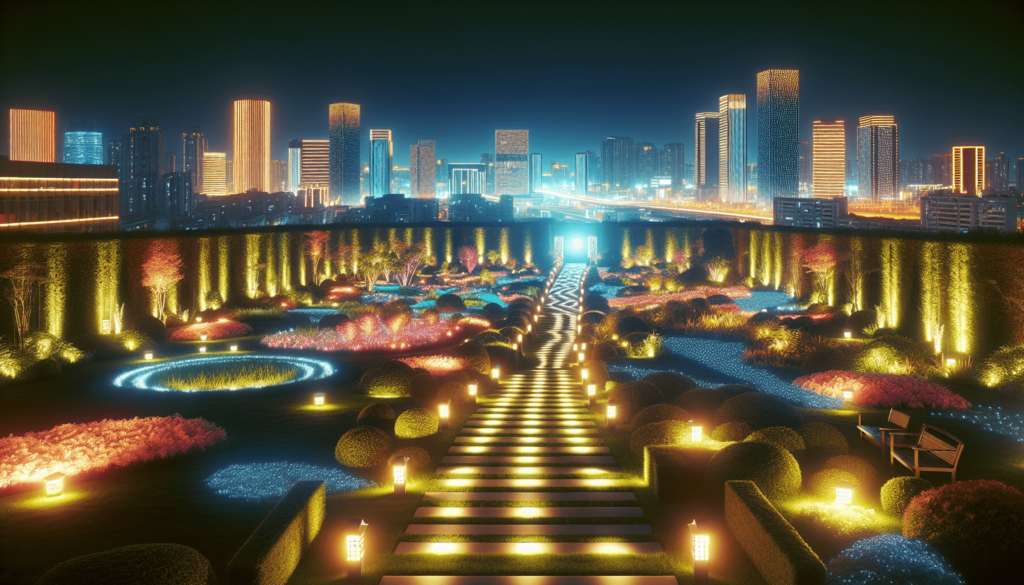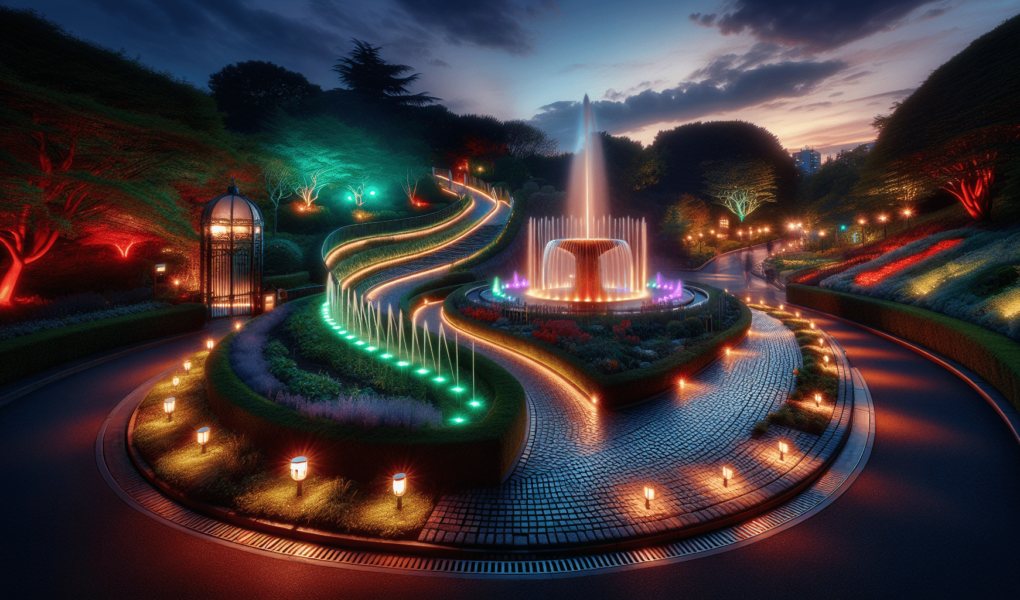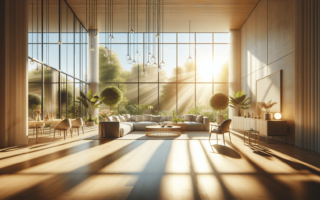Imagine strolling through a park at dusk, surrounded by lush greenery and a serene atmosphere. As the sun sets and darkness begins to envelop the world, a soft glow emerges, highlighting the pathways and accentuating the beauty of the surroundings. This captivating article explores the transformative power of lighting in open spaces, illuminating how thoughtful design and strategic placement of lights can enhance the charm and functionality of our beloved parks, gardens, and public areas. From safety and security to creating a magical ambiance, discover the art of lighting up open spaces in a way that not only brightens the night but also brings people closer to nature.

Benefits of Enhancing Open Spaces with Lighting
Open spaces, such as parks, plazas, and recreational areas, play a crucial role in our communities. They provide spaces for people to relax, exercise, and gather with friends and family. By enhancing these open spaces with the right lighting, we can unlock a multitude of benefits.
Increased safety and security
One of the primary benefits of lighting in open spaces is the increased safety and security it provides. Well-lit areas deter potential criminals, making them less likely to engage in illegal activities. Moreover, by illuminating walkways, stairs, and entrances, lighting ensures that people can navigate these spaces safely, reducing the risk of accidents and falls.
Extended usage during nighttime
With the right lighting, open spaces can be utilized beyond daylight hours. Many communities have limited access to recreational activities during the evening, but by illuminating parks and other outdoor areas, people can enjoy these spaces even after the sun goes down. This extended usage promotes a healthier lifestyle and encourages community engagement.
Enhanced aesthetics
Lighting has the power to transform the visual appeal of open spaces, creating a welcoming and captivating atmosphere. By strategically illuminating trees, structures, and architectural features, open spaces can take on a whole new dimension. Well-designed lighting not only enhances the aesthetics of the space but also adds beauty and charm, making it more appealing to visitors.
Improved wayfinding
Navigating large open spaces can be challenging, especially at night. By incorporating lighting into the design, wayfinding becomes easier and more intuitive. Pathway lights guide people along walkways and help them find their way through the space. This improved wayfinding not only enhances safety but also ensures that visitors can fully explore and enjoy the open space.
Opportunities for community activities
Open spaces serve as gathering places for communities, where people can come together for events and activities. By enhancing these spaces with lighting, a wealth of opportunities for community activities opens up. From evening concerts and outdoor movie screenings to cultural festivals and night markets, the possibilities are endless. Lighting creates a vibrant and inviting ambiance, making open spaces ideal for community gatherings.
Types of Lighting for Open Spaces
When it comes to illuminating open spaces, different lighting options can be utilized to achieve various effects and meet specific needs. Here are some common types of lighting used in open spaces:
Floodlights
Floodlights are powerful lighting fixtures that cast a wide beam of light over a large area. They are often used to provide general illumination for open spaces, such as parks or sports fields. Floodlights can effectively brighten up expansive areas and are ideal for spaces that require high levels of lighting.
Pathway lights
Pathway lights, also known as bollard lights, are low-level fixtures that line the pathways in open spaces. These lights help guide people along the walking paths, improving visibility and enhancing safety. Pathway lights can also be used to highlight the architectural features or landscaping elements within the open space, adding to its aesthetic appeal.
Spotlights
Spotlights are used to draw attention to specific focal points in an open space. They produce a focused, narrow beam of light, which can highlight sculptures, monuments, or other points of interest. Spotlights are commonly used in open spaces to accentuate architectural features or significant landmarks, adding a touch of drama and visual interest.
String lights
String lights, also referred to as fairy lights or festoon lights, are a popular lighting choice for creating a festive or whimsical atmosphere. These lights consist of small bulbs strung together in a line, often suspended overhead. String lights can be used to adorn trees, illuminate outdoor dining areas, or create a cozy ambiance for evening events in open spaces.
Pendant lights
Pendant lights are decorative fixtures that hang down from above, typically from a structure or a pole. These lights can provide both functional and aesthetic lighting in open spaces. Pendant lights can be used to illuminate seating areas, picnic tables, or outdoor stages, adding a touch of elegance and sophistication to the space.
Factors to Consider when Choosing Lighting for Open Spaces
Choosing the right lighting for open spaces requires careful consideration of various factors. By taking these factors into account, you can ensure that the lighting not only meets the functional requirements but also complements the surrounding environment.
Functionality and purpose
The primary purpose of the lighting in an open space should be defined first. Are you looking to provide general lighting for safety and security, or do you want to create a specific ambiance? Understanding the intended functionality will guide you in selecting the appropriate lighting fixtures.
Energy efficiency
In today’s world, it is essential to consider the energy efficiency of lighting solutions. LED lights are a popular choice for open spaces due to their low energy consumption and long lifespan. By opting for energy-efficient lighting options, you can reduce both your environmental impact and long-term operating costs.
Weather resistance
Open spaces are exposed to the elements, so it is critical to choose lighting fixtures that can withstand various weather conditions. Look for fixtures with high IP (Ingress Protection) ratings, which indicate the level of protection against dust and water. Weather-resistant lighting ensures durability and minimizes the need for frequent replacements or repairs.
Compatibility with the surrounding environment
The lighting should seamlessly blend into the surrounding environment and complement its aesthetics. Consider the architectural style, landscaping elements, and overall ambiance of the open space when selecting lighting fixtures. Choosing fixtures that harmonize with the surroundings will create a visually appealing and cohesive look.
Maintenance requirements
Maintenance is an ongoing aspect of lighting in open spaces. Consider the maintenance requirements of the lighting fixtures before making a decision. Opt for fixtures that are easily accessible for cleaning, bulb replacement, and repairs. Taking proactive measures for maintenance will help ensure the longevity and optimal performance of the lighting system.
Installation Process for Lighting in Open Spaces
Installing lighting in open spaces involves a systematic process to ensure the best results. Here are the key steps involved in the installation process:
Assessment of lighting needs
Start by assessing the lighting needs of the open space. Consider the size, purpose, and intended use of the space. Identify areas that require lighting, such as walkways, seating areas, or architectural features. Gathering data and understanding the specific requirements will guide the planning and design phase.
Planning the layout and design
Once the lighting needs are identified, create a lighting plan and design for the open space. This includes determining the placement of fixtures, the type of lighting to be used, and the desired effect. Collaborate with lighting designers, architects, and landscape designers to ensure a cohesive and well-thought-out lighting scheme.
Selection of suitable fixtures
Based on the lighting plan, select fixtures that are suitable for the open space. Consider factors such as the required brightness, the type of lighting effect desired, and the environmental conditions. Ensure that the selected fixtures are of high quality, durable, and have the necessary certifications for safety and performance.
Wiring and electrical installations
Once the fixtures are chosen, the next step is to plan and execute the necessary electrical installations. This involves laying out the wiring, installing junction boxes or control panels, and connecting the fixtures to a power source. It is crucial to follow electrical codes and safety guidelines during this process.
Testing and adjustments
After the electrical installations are complete, thoroughly test the lighting system to ensure proper functionality and performance. Adjustments may be necessary to achieve the desired lighting levels, distribution, or effects. Conduct nighttime tests to assess the overall impact of the lighting and make any necessary modifications.

Design Principles for Lighting in Open Spaces
To maximize the effectiveness and aesthetics of lighting in open spaces, it is important to follow design principles that create a visually pleasing and harmonious environment. Here are some key design principles to consider:
Layered lighting
Layered lighting involves combining different types of lighting fixtures and techniques to create depth and visual interest. By incorporating ambient, task, and accent lighting, you can highlight specific areas, create focal points, and establish a pleasant overall illumination.
Uniformity and proper distribution
Uniform lighting ensures that the entire open space is evenly illuminated, without any dark or overly bright spots. Proper distribution of light is crucial to avoid glare or strong shadows, creating a comfortable and inviting environment for visitors.
Colored lighting effects
Colored lighting can be used to create a specific ambiance or enhance the mood of the open space. Carefully chosen colors can add vibrancy, drama, or tranquility to the environment. Colored lighting effects are particularly effective in highlighting architectural features or creating visual interest in water elements.
Accentuating architectural features
Architectural features in open spaces, such as buildings, bridges, or sculptures, can be accentuated with lighting. By highlighting these features, you can create a stunning visual impact, draw attention to the unique aspects of the space, and showcase its architectural beauty.
Control systems and automation
Implementing control systems and automation allows for flexibility and convenience in managing the lighting. Dimming controls, timers, or motion sensors can optimize energy usage, tailor lighting levels to specific needs, and enhance the user experience. Consider incorporating smart lighting technologies that offer programmable and customizable lighting solutions.
Maintenance and Upkeep of Lighting in Open Spaces
To ensure the longevity and optimal performance of lighting in open spaces, regular maintenance and upkeep are essential. Here are some key aspects to consider:
Regular cleaning and bulb replacement
Dirt, dust, and debris can accumulate on lighting fixtures over time, reducing their effectiveness. Regular cleaning of fixtures and replacing worn-out bulbs will help maintain optimal lighting levels and prevent any decline in performance or aesthetics.
Testing and troubleshooting
Periodically test the lighting system to identify any potential issues or malfunctions. Conduct routine inspections to ensure that all fixtures are functioning correctly, and address any problems promptly. This proactive approach will minimize downtime and ensure the safety and functionality of the lighting.
Repairing damaged fixtures
Open spaces are exposed to various elements that can cause damage to lighting fixtures. Inspect the fixtures regularly for any signs of damage, such as cracks, corrosion, or loose connections. Repair or replace damaged fixtures promptly to maintain the integrity of the lighting system.
Upgrading to energy-efficient technologies
As technology advances, newer lighting technologies with greater energy efficiency become available. Consider upgrading the lighting system with energy-efficient LED fixtures or other sustainable solutions. This not only reduces energy consumption but also lowers operating costs in the long run.
Implementing preventive maintenance schedules
Establishing a preventive maintenance schedule is crucial to ensure the ongoing performance and longevity of the lighting system. Regular maintenance tasks, such as lubricating mechanical parts, checking electrical connections, and updating software, should be performed as per the manufacturer’s recommendations. Implementing a proactive maintenance approach minimizes costly repairs and extends the lifespan of the lighting system.

Cost Considerations for Lighting in Open Spaces
When planning to enhance open spaces with lighting, cost considerations play a significant role. Here are some key cost factors to keep in mind:
Initial investment in fixtures and equipment
The initial investment in lighting fixtures, equipment, and installation can vary depending on the size and complexity of the open space. Consider the budget allocation required for purchasing high-quality fixtures and the cost of hiring professionals for installation.
Operating and maintenance costs
Beyond the initial investment, operating and maintenance costs should be factored into the budget. This includes the cost of electricity consumption, routine maintenance tasks, and any unexpected repairs or replacements. Opting for energy-efficient lighting solutions can help minimize operating costs in the long run.
Potential energy savings
By investing in energy-efficient lighting technologies, open spaces can significantly reduce energy consumption and, consequently, energy costs. Conduct an analysis of potential energy savings from using LED or solar-powered lighting systems to determine the long-term cost benefits and return on investment.
ROI (Return on Investment) analysis
Performing a return on investment analysis can help assess the financial viability of the lighting project. Calculate the payback period by comparing the initial investment and ongoing operational costs with the potential energy savings and other benefits gained from the enhanced lighting. This analysis helps justify the investment and determine the cost-effectiveness of different lighting options.
Budget allocation and funding options
Consider the available budget and explore various funding options for the lighting project. Seek potential grants, sponsorships, or partnerships with local organizations or businesses that align with the goals of the open space enhancement. Creatively allocating the budget will help ensure that the lighting project can be successfully implemented within the allocated funds.
Case Studies: Successful Use of Lighting in Open Spaces
Examining successful case studies can provide valuable insights into the effective use of lighting in open spaces. Here are a few notable examples:
Central Park, New York City
Central Park in New York City is a prime example of effective lighting enhancing an open space. The park features strategically placed path lights and accent lighting that highlight iconic landmarks, such as the Bethesda Terrace and Bow Bridge. The lighting scheme creates a magical ambiance, making the park a popular destination for both locals and tourists, even during the night hours.
The Singapore River
The Singapore River is a vibrant waterfront area that utilizes lighting to transform the entire space. Multi-colored LED lights illuminate the river’s edge, creating a captivating visual display that enchants visitors. The lighting design complements the modern architecture and enhances the vibrant atmosphere, making it a must-visit destination in Singapore.
The High Line, New York City
The High Line, an elevated park built on a former railway track in New York City, showcases innovative lighting practices. The park features a combination of pathway lights, spotlights, and string lights that create a unique and enchanting atmosphere. The lighting scheme beautifully highlights the park’s greenery and architectural features, providing a memorable experience for visitors.
The Gyeongju Tower, South Korea
The Gyeongju Tower in South Korea is an iconic structure that is beautifully enhanced with lighting. The tower features a sophisticated lighting design that highlights its unique shape and cultural significance. The lighting effects change dynamically, creating a mesmerizing visual display that adds to the tower’s allure.
The Sheikh Zayed Bridge, Abu Dhabi
The Sheikh Zayed Bridge in Abu Dhabi showcases the creative use of lighting to elevate a bridge into a work of art. The bridge’s architecture is accentuated by programmable LED fixtures that create vibrant lighting patterns and colors. The lighting design transforms the bridge into a stunning landmark that complements the city’s futuristic skyline.

Sustainable Lighting Practices for Open Spaces
With a growing focus on sustainability, incorporating eco-friendly lighting practices in open spaces is crucial. Here are some sustainable lighting practices to consider:
LED lighting technology
LED (Light Emitting Diode) lighting technology offers significant energy savings and long lifespan compared to traditional lighting sources. LED fixtures are highly efficient, consume less energy, and produce minimal heat. By replacing conventional lighting sources with LEDs, open spaces can reduce energy consumption and lower operating costs.
Motion sensors and timers
Incorporating motion sensors and timers in lighting systems helps optimize energy usage. Motion sensors detect movement and automatically turn on the lights when someone is present. Timers can be programmed to switch off the lights during periods of low activity or during daylight hours. These smart control features prevent unnecessary energy wastage and contribute to energy efficiency.
Solar-powered lighting
Solar-powered lighting utilizes the energy from the sun to power outdoor lighting fixtures. A solar panel collects solar energy during the day and stores it in a battery, which then powers the lights at night. These sustainable lighting solutions eliminate the need for grid electricity and reduce overall energy consumption.
Light pollution mitigation
Light pollution is a significant concern that affects the environment and disrupts ecosystems. By utilizing lighting fixtures that are designed to minimize light spillage and glare, open spaces can mitigate light pollution. Well-designed shields and optics can direct the light where it is needed, without causing unnecessary sky glow or negatively impacting nocturnal wildlife.
Smart lighting control systems
Smart lighting control systems offer advanced features and automation capabilities. These systems allow for precise control over the lighting levels, color, and timing. By integrating sensors, dimmers, and wireless controls, open spaces can optimize lighting conditions based on user preferences, time of day, or specific events. Smart lighting systems help conserve energy and provide a customizable lighting experience.
Conclusion
Enhancing open spaces with appropriate lighting can provide numerous benefits to communities. From increased safety and extended nighttime usage to enhanced aesthetics and improved wayfinding, lighting plays a crucial role in creating vibrant and inviting public spaces. By considering various factors and following design principles, the lighting in open spaces can be both functional and visually appealing. Sustainable lighting practices should be prioritized to reduce energy consumption and minimize environmental impact. With careful planning, installation, and maintenance, open spaces can be transformed into beautifully illuminated environments that foster community engagement and wellbeing.



